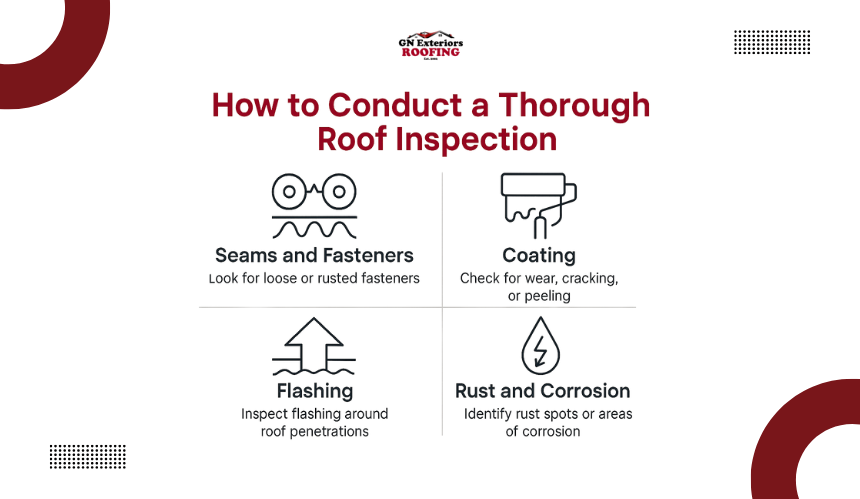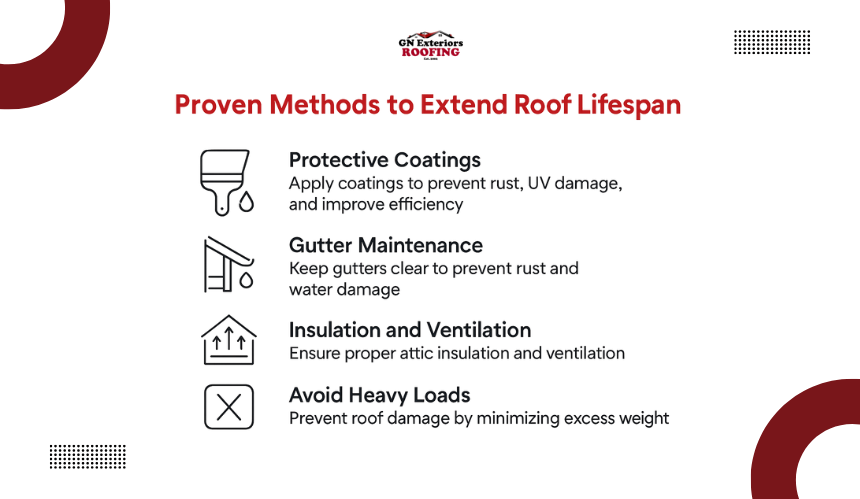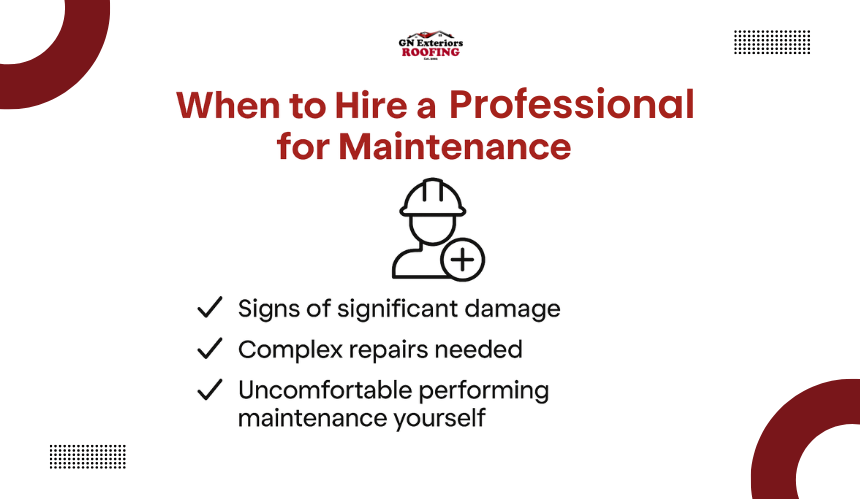
A metal roof is one of the most durable and long-lasting roofing options available today. Known for its resistance to harsh weather conditions, energy efficiency, and minimal maintenance requirements, a well-maintained metal roof can last decades.
However, like any other roofing material, metal roofs require regular care to ensure they perform at their best. Neglecting proper maintenance can lead to costly repairs or even early replacement.
In this 2026 maintenance guide, we’ll walk you through the essential steps for cleaning, inspecting, and extending the lifespan of your metal roof.

Cleaning a metal roof is essential to maintaining its appearance and functionality. Over time, dirt, leaves, algae, moss, and other debris can accumulate, potentially causing damage to the roof’s surface or blocking gutters. The key to effective cleaning is using the right methods and tools that won’t harm the roof’s finish.
Start by removing loose debris with a soft-bristle broom or a leaf blower. Be cautious not to scratch the surface. For deeper cleaning, use a mild detergent mixed with water to scrub the surface. For roofs with tough stains, such as bird droppings or algae growth, opt for specialized metal roof cleaners designed to remove these stains without harming the material.
When cleaning, always work in sections, starting from the top of the roof and working downward to prevent water from running under the shingles or panels. It’s also crucial to avoid using high-pressure washing equipment, as the force could cause damage to the seams or coating, leading to long-term issues like rust or corrosion.
While cleaning your metal roof may seem straightforward, certain mistakes can cause irreversible damage. First, never use abrasive tools or harsh chemicals. Steel wool pads or strong solvents can strip away protective coatings, leaving the metal exposed to the elements.
Additionally, avoid cleaning on extremely hot days, as direct sunlight can cause the cleaning solution to dry too quickly, leaving streaks or residue behind.
Another mistake to avoid is walking on the roof while cleaning. Doing so can dent or warp the metal panels, especially if you’re not using the proper footwear. If you need to get up on the roof, make sure to use a ladder with proper safety measures in place.
By following the right cleaning practices and being mindful of these common mistakes, you can preserve the integrity of your metal roof for years to come.

Regular inspections are essential to detect early signs of damage and ensure that your metal roof continues to protect your home. Start by visually inspecting the roof from the ground using binoculars or a drone for an overall view. Look for any obvious signs of wear, such as missing or loose panels, rust spots, or damage to the seams.
For a more thorough inspection, consider getting on the roof. Always ensure safety by using a sturdy ladder and wearing non-slip shoes. Walk carefully across the roof and examine the following areas:
If you find any areas of concern, it’s vital to address them promptly to prevent further damage and expensive repairs.
While metal roofs are known for their longevity, regular inspections are key to avoiding issues before they become severe. Ideally, you should inspect your roof twice a year: once in the spring and once in the fall. This allows you to catch any damage that may have occurred over the course of the changing seasons.
Early inspections after extreme weather conditions can help you identify minor issues, such as loose fasteners or small dents, before they turn into larger problems. By staying proactive with inspections, you can avoid costly repairs and maintain the roof’s long-term effectiveness.

A metal roof is built to last, but its longevity depends on regular upkeep. To maximize its lifespan, consider these proven methods:
By taking these proactive measures, you can extend the life of your metal roof and maintain its performance for decades.
Rust and corrosion are the two biggest threats to a metal roof’s lifespan. To avoid these issues, start with a high-quality metal that is naturally resistant to rust, such as galvanized steel or aluminum. Even if your roof is made of rust-resistant materials, regular maintenance is key to preventing corrosion.
One of the most effective ways to avoid rust is to regularly inspect the roof for any signs of wear or damage to the protective coating. If you notice any peeling or exposed metal, apply a touch-up coating immediately. Additionally, consider using anti-corrosion products designed specifically for metal roofs to prevent rust from forming in vulnerable areas.

While many metal roof maintenance tasks can be handled by homeowners, certain situations call for a metal roofing professional. If your roof shows signs of significant damage, such as large dents, rusted areas, or structural issues, it’s time to call in a professional.
Additionally, if you’re uncomfortable performing inspections or cleaning yourself, a roofing contractor can ensure that the job is done safely and effectively.
Professionals can also assess the roof’s overall condition and provide long-term solutions to address any underlying issues that you might not be able to detect on your own. For complex repairs, such as fixing leaks or replacing panels, it’s best to leave the job to experts who have the necessary skills and tools.
Choosing the right roofing contractor is critical for ensuring that your roof receives proper care. Start by researching local roofers with experience in metal roofing. Look for companies with positive reviews, proper licenses, and insurance coverage.
When evaluating potential contractors, ask for references and check their track record of completing similar jobs. Ensure that they offer a comprehensive warranty for their work, as this can provide peace of mind in case future issues arise.
Ready to protect your roof with top-quality service? Choose GN Exteriors for expert care and unbeatable transparency. Our team delivers reliable, high-quality roofing solutions tailored to your needs. Contact us today for a free consultation and see the difference!
As we move into 2026, the future of metal roof maintenance is focused on innovation, sustainability, and efficiency. Smart roof systems are gaining popularity, with sensors that monitor the roof’s condition in real-time, detecting issues like leaks, moisture, and temperature changes before they escalate into major problems. These technologies allow for quicker, more proactive maintenance, reducing the risk of costly repairs.
In addition, eco-friendly coatings are becoming more advanced, offering enhanced corrosion resistance while also improving energy efficiency by reflecting solar heat. Homeowners are increasingly choosing these coatings to reduce both maintenance and cooling costs.
Finally, lighter, more durable alloys are being developed, making metal roofs even more resilient and easier to maintain. These advancements ensure that metal roofs not only last longer but also require less upkeep, allowing homeowners to protect their investment for years to come.
Yes, you can install solar panels on a metal roof! Metal roofs are an excellent choice for solar panel installation due to their durability and ability to support additional weight.
It is important to work with professionals who are experienced in mounting solar systems on metal roofs to ensure proper installation without compromising the roof’s integrity.
To boost the energy efficiency of your metal roof, consider adding reflective coatings or installing a cool roof system. These solutions help reflect more sunlight, keeping your home cooler in the summer and reducing energy costs. Additionally, proper attic insulation and ventilation can enhance overall energy efficiency by preventing heat buildup.
Yes, eco-friendly roof cleaning products are available and can effectively clean metal roofs without harming the environment. Look for biodegradable, non-toxic cleaners that are safe for plants and animals. These products help remove algae, moss, and debris while minimizing the environmental impact of your roof maintenance.
While no roof is completely hailproof, you can minimize damage by choosing impact-resistant metal roofing materials, such as thicker gauges or specialized coatings designed to withstand hail. Additionally, consider installing protective measures like roof hail guards or adding a layer of insulation beneath the metal panels for added cushioning.
Metal roof colors and designs have evolved with trends focusing on both aesthetics and functionality. Popular trends include matte finishes, dark hues (like charcoal gray and black), and even solar-reflective colors. Modern designs now feature standing seam roofs with hidden fasteners, creating sleek, contemporary looks while ensuring long-term performance and durability.